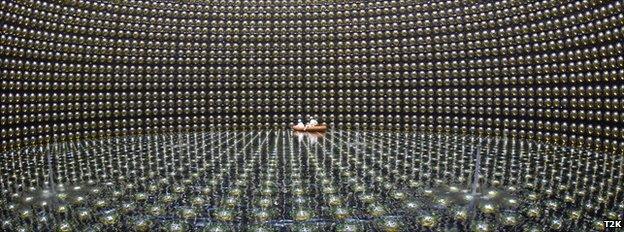Neutrino particle 'flips to all flavours'
- Published

The detector works by looking for flashes of light from particles that exceed the speed of light in the water
An important breakthrough may be imminent in the study of neutrinos.
The multinational T2K project in Japan says it has seen indications in its data that these elementary particles can flip to any of their three types.
The results are provisional because experiments had to be suspended in the wake of the Tohoku earthquake in March.
But if confirmed, they would open the door to further research on why there is so much more matter than antimatter in our Universe.
Theorists say the counterparts should have been created in equal amounts at the Big Bang, and should have annihilated each other. That normal matter now dominates the cosmos is a major puzzle.
"It's a step on the road," explained Professor Dave Wark, of Imperial College London and the STFC's Rutherford Appleton Laboratory, which leads the UK involvement in T2K.
"We want to address this asymmetry, but first we have to show that the different 'flavours' of neutrinos can spontaneously change into each other - something we call 'neutrino oscillation'. So far, our experiments have been very positive," he told BBC News.
Detecting 'ghosts'
Neutrinos are among the fundamental building blocks of matter. They swarm all about us.
The Sun, for example, releases them in huge quantities when it fuses hydrogen to make helium - the raw nuclear process at its core.
They are, however, very difficult to study because they interact so weakly with normal matter. Hence, their nickname - "ghost particles".
Nonetheless, scientists have been able to discern three flavours - electron neutrinos, muon neutrinos, and tau neutrinos.
Previous research has characterised two forms of oscillations.
The T2K experiment has now seen hints for a third transformation - that of a muon neutrino turning into an electron neutrino.
Side to side
T2K is an extraordinary set-up built in two parts.
At one end is the Japan Proton Accelerator Research Centre (J-Parc) on the country's east coast. It generates a beam of muon neutrinos that it fires under the ground for 295km to the mammoth Super-Kamiokande facility on the west coast.
The Super-K, as it is sometimes called, is a tank of 50,000 tonnes of ultra-pure water surrounded by sensitive optical detectors.
These photomultiplier tubes pick up the very rare, very faint flashes of light emitted when passing neutrinos interact with the water.
In experiments this year that ran on T2K until the quake damaged equipment, scientists saw an excess of electron neutrinos turning up at Super-K.
In other words, it appears the muon neutrinos sent from J-Parc had changed flavour in flight.
The statistics are not big enough to claim a discovery, but it has the T2K collaboration excited and keen to get up and running again.
Symmetry violation
"The oscillations of neutrinos are governed by three angles which you can think of like pitch, yaw and roll for an aeroplane," explained Professor Wark.
"In the past, we've measured pitch and yaw, but we had no sign that roll was different from zero. If these turn out to be real events, then we'll have shown that roll is not equal to zero."
The missing angle is actually referred to as "theta-one-three". If it really does have a non-zero quantity, it opens the possibility that the oscillations of neutrinos and their antiparticles (antineutrinos) could be different.
That would be an example of what physicists call CP violation and a potential explanation for why the normal matter and antimatter created at the Big Bang did not simply annihilate each other, but instead left an excess of normal matter.
"There have to be some laws of physics we don't know about because all the laws we do know about cannot produce any significant excess of matter over antimatter. There are a number of places these laws could be hiding, and one of the most promising places to look is neutrinos," said Professor Wark.
"But the first step has to be to prove that theta-one-three is not equal to zero. If it were then neutrinos and antineutrinos would have to oscillate the same way - there just aren't enough degrees of freedom to allow them to be different."
Repairs at J-Parc should have the experiments gathering data again by the end of the year.
- Published6 June 2011
- Published24 September 2010
- Published23 September 2010
- Published22 June 2010